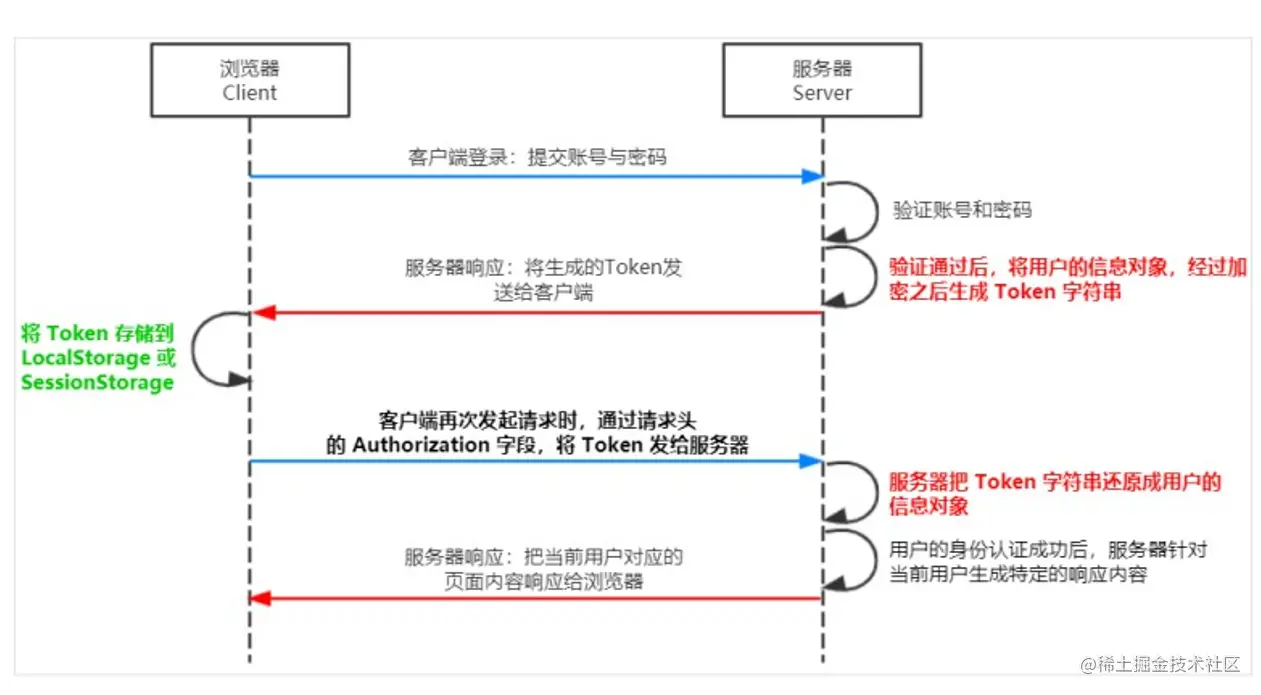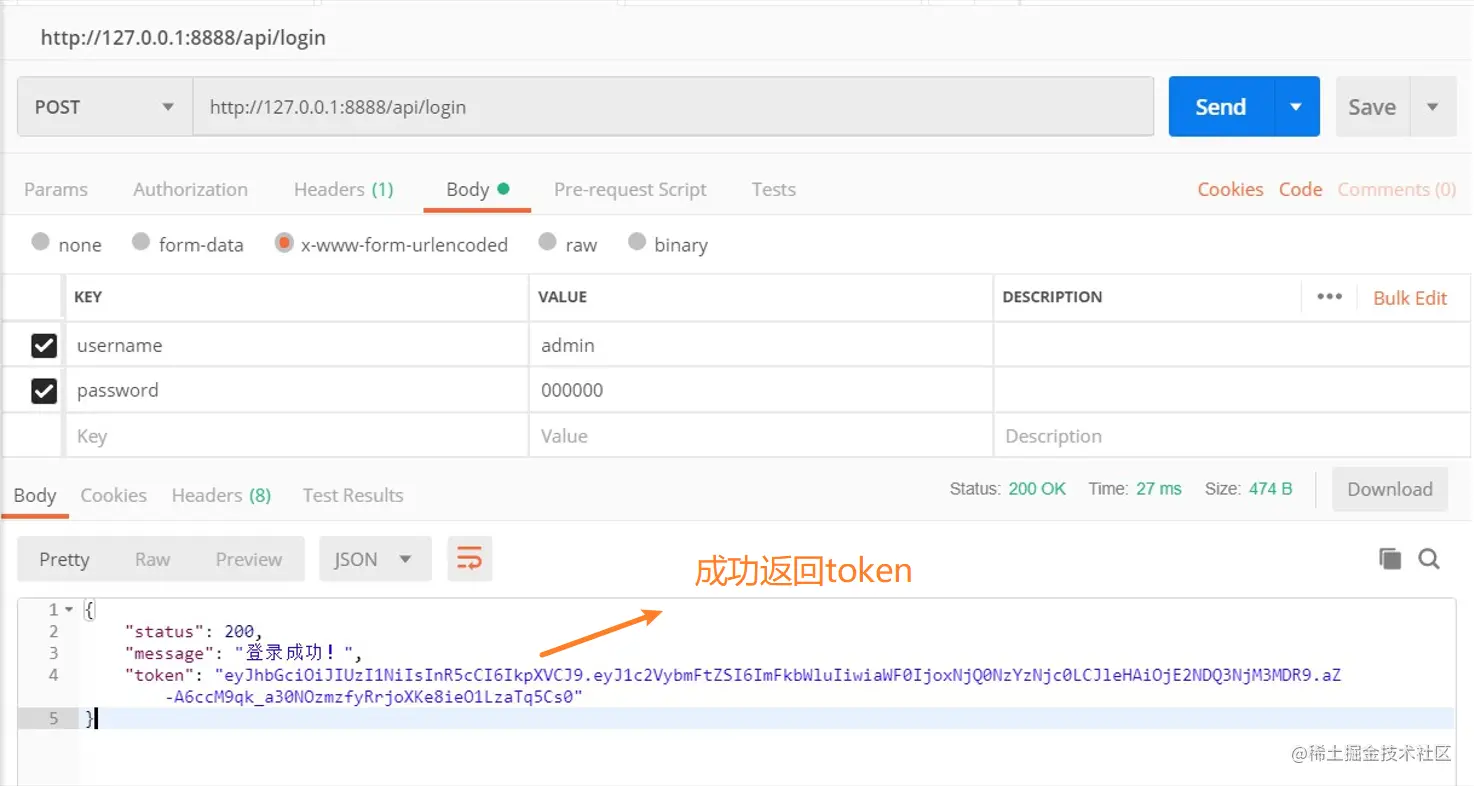Home >Web Front-end >JS Tutorial >What is JWT? How to implement JWT authentication mechanism in Node (a brief analysis)
What is JWT? How to implement JWT authentication mechanism in Node (a brief analysis)
- 青灯夜游forward
- 2022-10-28 19:37:291975browse
This article will talk to you about the related principles of back-end JWT authentication and how to use it in Node. I hope it will be helpful to everyone, thank you.

[Related tutorial recommendations: nodejs video tutorial]
1. Why use JWT
The emergence of one technology is to make up for the shortcomings of another technology. Before the emergence of JWT, the Session authentication mechanism needed to be implemented with Cookie. Since Cookie does not support cross-domain access by default, when it comes to the front-end cross-domain request to the back-end interface, a lot of additional configuration is required to achieve cross-domain Session authentication.
Note:
- When the front-end requests the back-end interface and there are no cross-domain issues, it is recommended to use the Session authentication mechanism.
- When the front-end needs to request the back-end interface across domains, it is not recommended to use the Session authentication mechanism. It is recommended to use the JWT authentication mechanism.
2. What is JWT
JWT (full English name: JSON Web Token) is currently the most popular cross-domain authentication solution plan. The essence is a string writing specification, as shown below, which is used to transfer safe and reliable information between users and servers.

token authentication mechanism for identity verification is the most common solution. The process is as follows:
- When the server verifies that the user account and password are correct, it issues a token to the user. token, this token is used as a credential for subsequent users to access some interfaces
- Subsequent visits will use this token to determine whether the user has permission to access
3. Working principle of JWT

restoring the Token string.
4. The components of token
Token is divided into three parts, Header, Payload, and Signature ( Signature) and spliced with .. The header and payload store data in JSON format, but are encoded. The format is as follows:
Header.Payload.SignatureThe following is an example of a JWT string:
Bearer eyJhbGciOiJIUzI1NiIsInR5cCI6IkpXVCJ9.eyJ1c2VybmFtZSI6ImFkbWluIiwiaWF0IjoxNjQ0ODI3NzI2LCJleHAiOjE2NDQ4Mjc3NTZ9.gdZKg9LkPiQZIgNAZ1Mn14GQd9kZZua-_unwHQoRsKENote: Bearer is a manually added header information, and this information must be carried to parse the token!
5. The meaning of the three parts of token
1. header
Each JWT will have a header Information, here mainly declares the algorithm used. The field name for declaring the algorithm isalg, and there is also a field named typ. The default is JWT. The algorithm in the following example is HS256:
{ "alg": "HS256", "typ": "JWT" }Because JWT is a string, we also need to Base64 encode the above content. The encoded string is as follows:
eyJhbGciOiJIUzI1NiIsInR5cCI6IkpXVCJ9
2. payload
The payload is the message body, where the actual content will be stored, which is the data declaration ofToken, such as the user's id and name, by default it will also carry the issuance time of the token iat, and you can also set the expiration time, as follows:
{
"sub": "1234567890",
"name": "CoderBin",
"iat": 1516239022
}After the same Base64 encoding, the string is as follows:
eyJzdWIiOiIxMjM0NTY3ODkwIiwibmFtZSI6IkpvaG4gRG9lIiwiaWF0IjoxNTE2MjM5MDIyfQ
3. Signature
Signature is to sign the header and payload content. Generally, set asecretKey to the results of the first two Perform the HMACSHA25 algorithm, the formula is as follows:
Signature = HMACSHA256(base64Url(header)+.+base64Url(payload),secretKey)Once the first two parts of data are tampered with, as long as the key used for server encryption is not leaked, the obtained signature will definitely be inconsistent with the previous signature
6. How to use JWT
After the client receives the JWT returned by the server, it usually stores it inlocalStorage or sessionStorage middle.
put the JWT in the Authorization field of the HTTP request header, in the following format:
Authorization: Bearer <token></token>
7. JWT implementation
## The use of #Token is divided into two parts:
- Verify the token: When accessing certain resources or interfaces, verify the token
- Next, I will take you to implement jwt authentication in the
environment. Finally, there is the complete code with comments. You can directly look at the final code<h3 data-id="heading-11"><strong>1. 安装 JWT 相关的包</strong></h3>
<p>运行如下命令,安装如下两个 JWT 相关的包:</p><pre class="brush:js;toolbar:false;">npm i jsonwebtoken express-jwt</pre><p>其中:</p>
<ul>
<li>
<code>jsonwebtoken 用于生成 JWT 字符串
express-jwt 用于验证token,将 JWT 字符串解析还原成 JSON 对象2. 导入 JWT 相关的包
在app.js中
// 导入用于生成 JWT 字符串的包
const jwt = require('jsonwebtoken')
// 导入用户将客户端发送过来的 JWT 字符串,解析还原成 JSON 对象的包
const expressJWT = require('express-jwt')
3. 定义 secret 密钥 *
为了保证 JWT 字符串的安全性,防止 JWT 字符串在网络传输过程中被别人破解,我们需要专门定义一个用于加密和解密的 secret 密钥:
当生成 JWT 字符串的时候,需要使用 secret 密钥对用户的信息进行加密,最终得到加密好的 JWT 字符串
当把 JWT 字符串解析还原成 JSON 对象的时候,需要使用 secret 密钥进行解密
// 这个 secretKey 的是可以是任意的字符串 const secretKey = 'CoderBin ^_^'
4. 在登录成功后生成 JWT 字符串 *
调用 jsonwebtoken 包提供的 sign() 方法,将用户的信息加密成 JWT 字符串,响应给客户端:
- 参数 1:用户的信息对象
- 参数 2:解密的秘钥
- 参数 3:配置对象,可以配置 token 的有效期
注意:千万不要把密码加密到 token 字符串中!
// 登录接口
app.post('/api/login', function (req, res) {
// 将 req.body 请求体中的数据,转存为 userinfo 常量
const userinfo = req.body
// 省略登录失败情况下的代码...
// 登录成功
// 在登录成功之后,调用 jwt.sign() 方法生成 JWT 字符串。并通过 token 属性发送给客户端
const tokenStr = jwt.sign(
{ username: userinfo.username },
secretKey,
{ expiresIn: '30s' }
)
// 向客户端响应成功的消息
res.send({
status: 200,
message: '登录成功!',
token: tokenStr // 要发送给客户端的 token 字符串
})
})
5. 将 JWT 字符串还原为 JSON 对象 *
客户端每次在访问那些有权限接口的时候,都需要主动通过请求头中的 Authorization 字段,将 Token 字符串发送到服务器进行身份认证。
此时,服务器可以通过 express-jwt 这个中间件,自动将客户端发送过来的 Token 解析还原成 JSON 对象:
-
express.JWT({ secret: secretKey, algorithms: ['HS256'] })就是用来解析 Token 的中间件 - express-jwt 模块,现在默认为 6版本以上,必须加上:
algorithms: ['HS256']
注意:只要配置成功了 express-jwt 这个中间件,就会自动把解析出来的用户信息,挂载到 req.user 属性上
// 1. 使用 app.use() 来注册中间件
app.use(expressJWT({
secret: secretKey,
algorithms: ['HS256']
}).unless({ path: [/^\/api\//] }))
注意:
- secret 必须和 sign 时候保持一致
- 可以通过 unless 配置接口白名单,也就是哪些 URL 可以不用经过校验,像登陆/注册都可以不用校验
- 校验的中间件需要放在需要校验的路由前面,无法对前面的 URL 进行校验
6. 使用 req.user 获取用户信息
当 express-jwt 这个中间件配置成功之后,即可在那些有权限的接口中,使用 req.user 对象,来访问从 JWT 字符串中解析出来的用户信息了,示例代码如下:
// 这是一个有权限的 API 接口,必须在 Header 中携带 Authorization 字段,值为 token,才允许访问
app.get('/admin/getinfo', function (req, res) {
// TODO_05:使用 req.user 获取用户信息,并使用 data 属性将用户信息发送给客户端
console.log(req.user);
res.send({
status: 200,
message: '获取用户信息成功!',
data: req.user // 要发送给客户端的用户信息
})
})
7. 捕获解析 JWT 失败后产生的错误
当使用 express-jwt 解析 Token 字符串时,如果客户端发送过来的 Token 字符串过期或不合法,会产生一个解析失败的错误,影响项目的正常运行。我们可以通过 Express 的错误中间件,捕获这个错误并进行相关的处理,示例代码如下:
app.use((err, req, res, next) => {
// 这次错误是由 token 解析失败导致的
if (err.name === 'UnauthorizedError') {
return res.send({
status: 401,
message: '无效的token'
})
}
res.send({
status: 500,
message: '未知的错误'
})
})
8. 完整代码
app.js
// 导入 express 模块
const express = require('express')
// 创建 express 的服务器实例
const app = express()
// TODO_01:安装并导入 JWT 相关的两个包,分别是 jsonwebtoken 和 express-jwt
const jwt = require('jsonwebtoken')
const expressJWT = require('express-jwt')
// 允许跨域资源共享
const cors = require('cors')
app.use(cors())
// 解析 post 表单数据的中间件
const bodyParser = require('body-parser')
// 这里用内置的中间件也行: app.use(express.urlencoded({ extended: false }))
app.use(bodyParser.urlencoded({ extended: false }))
// TODO_02:定义 secret 密钥,建议将密钥命名为 secretKey
// 这个 secretKey 的是可以是任意的字符串
const secretKey = 'smiling ^_^'
// TODO_04:注册将 JWT 字符串解析还原成 JSON 对象的中间件
// 1. 使用 app.use() 来注册中间件
// 2. express.JWT({ secret: secretKey, algorithms: ['HS256'] }) 就是用来解析 Token 的中间件
// 2.1 express-jwt 模块,现在默认为 6版本以上,必须加上: algorithms: ['HS256']
// 3. .unless({ path: [/^\/api\//] }) 用来指定哪些接口不需要访问权限
// 4. 注意:只要配置成功了 express-jwt 这个中间件,就会自动把解析出来的用户信息,挂载到 req.user 属性上
app.use(expressJWT({ secret: secretKey, algorithms: ['HS256'] }).unless({ path: [/^\/api\//] }))
// 登录接口
app.post('/api/login', function (req, res) {
// 将 req.body 请求体中的数据,转存为 userinfo 常量
const userinfo = req.body
// 登录失败
if (userinfo.username !== 'admin' || userinfo.password !== '000000') {
return res.send({
status: 400,
message: '登录失败!'
})
}
// 登录成功
// TODO_03:在登录成功之后,调用 jwt.sign() 方法生成 JWT 字符串。并通过 token 属性发送给客户端
// 参数 1:用户的信息对象
// 参数 2:解密的秘钥
// 参数 3:配置对象,可以配置 token 的有效期
// 记住:千万不要把密码加密到 token 字符串中!
const tokenStr = jwt.sign({ username: userinfo.username }, secretKey, { expiresIn: '30s' })
res.send({
status: 200,
message: '登录成功!',
token: tokenStr // 要发送给客户端的 token 字符串
})
})
// 这是一个有权限的 API 接口,必须在 Header 中携带 Authorization 字段,值为 token,才允许访问
app.get('/admin/getinfo', function (req, res) {
// TODO_05:使用 req.user 获取用户信息,并使用 data 属性将用户信息发送给客户端
console.log(req.user);
res.send({
status: 200,
message: '获取用户信息成功!',
data: req.user // 要发送给客户端的用户信息
})
})
// TODO_06:使用全局错误处理中间件,捕获解析 JWT 失败后产生的错误
app.use((err, req, res, next) => {
// 这次错误是由 token 解析失败导致的
if (err.name === 'UnauthorizedError') {
return res.send({
status: 401,
message: '无效的token'
})
}
res.send({
status: 500,
message: '未知的错误'
})
})
// 调用 app.listen 方法,指定端口号并启动web服务器
app.listen(8888, function () {
console.log('Express server running at http://127.0.0.1:8888')
})
八. 测试结果
1 测试登录接口
借助 postman 工具测试接口

2. 测试登录需要权限的接口-失败
3. 测试登录需要权限的接口-成功
九、最后总结
JWT鉴权机制有许多优点:
- json具有通用性,所以可以跨语言
- 组成简单,字节占用小,便于传输
- 服务端无需保存会话信息,很容易进行水平扩展
- 一处生成,多处使用,可以在分布式系统中,解决单点登录问题
- 可防护CSRF攻击
当然,不可避免的也有一些缺点:
- The payload part is only simply encoded, so it can only be used to store non-sensitive information necessary for logic
- It is necessary to protect the encryption key. Once it is leaked, the consequences will be unimaginable
- To avoid token being hijacked, it is best to use the https protocol
This brief analysis of the JWT authentication mechanism ends here. I hope it will be helpful to everyone, thank you!
For more node-related knowledge, please visit: nodejs tutorial!
The above is the detailed content of What is JWT? How to implement JWT authentication mechanism in Node (a brief analysis). For more information, please follow other related articles on the PHP Chinese website!
Related articles
See more- What is a DDos attack? How does the node SSR service prevent and handle attacks?
- How to do Docker mirroring of Node service? Detailed explanation of extreme optimization
- An article explaining the event loop in Node.js in detail
- Take you to use Node to read and write txt and Excel files
- See how to use nodejs to generate QR codes
- A brief analysis of how node implements github third-party login


)
)